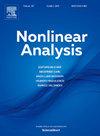Long-time asymptotics of the damped nonlinear Klein–Gordon equation with a delta potential
IF 1.3
2区 数学
Q1 MATHEMATICS
引用次数: 0
Abstract
We consider the damped nonlinear Klein–Gordon equation with a delta potential: where , , and denotes the Dirac delta with the mass at the origin. When , Côte et al. (2021) proved that any global solution either converges to 0 or to the sum of decoupled solitary waves which have alternative signs. In this paper, we first prove that any global solution either converges to 0 or to the sum of decoupled solitary waves. We then construct a single solitary wave solution that moves away from the origin when and construct an even 2-solitary wave solution when . Last we give single solitary wave solutions and even 2-solitary wave solutions an upper bound for the distance between the origin and the solitary wave.
求助全文
约1分钟内获得全文
求助全文
来源期刊
CiteScore
3.30
自引率
0.00%
发文量
265
审稿时长
60 days
期刊介绍:
Nonlinear Analysis focuses on papers that address significant problems in Nonlinear Analysis that have a sustainable and important impact on the development of new directions in the theory as well as potential applications. Review articles on important topics in Nonlinear Analysis are welcome as well. In particular, only papers within the areas of specialization of the Editorial Board Members will be considered. Authors are encouraged to check the areas of expertise of the Editorial Board in order to decide whether or not their papers are appropriate for this journal. The journal aims to apply very high standards in accepting papers for publication.

 求助内容:
求助内容: 应助结果提醒方式:
应助结果提醒方式:


